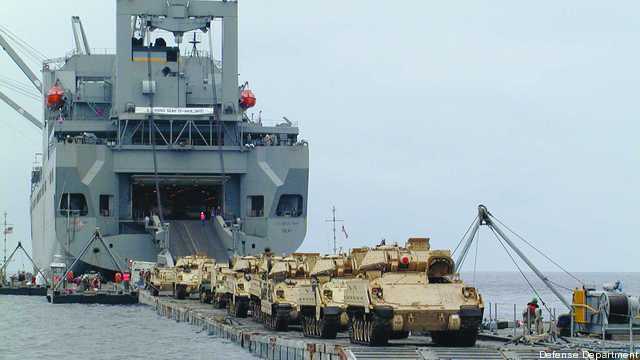 While the Marines are famous for amphibious landings, they depend on Army assets (shown here) for large-scale logistics.
While the Marines are famous for amphibious landings, they depend on Army assets (shown here) for large-scale logistics.
Going back to the future ain’t easy. After a decade largely spent waging land wars in Afghanistan and Iraq, the U.S. Marine Corps wants to reemphasize large-scale amphibious operations, like its recent “Bold Alligator” exercise. But to do that in the face of rising threats, shrinking budgets, and limited assets, they’re going to have to rely not only on their traditional partners in the U.S. Navy but increasingly on the Army, friendly nations, and even the commercial sector for logistical support to get them ashore.
“As time goes on, we’re going to get driven to more commercial solutions,” Marine Lt. Col. Dutch Bertholf, a Joint Staff planner, told participants at the Marine Corps’ annual “Expeditionary Warrior” wargame, as he displayed a slide showing the projected decline in the Navy’s logistics fleet after 2020. Already, he noted, “we got to see this a bit in Haiti,” where the U.S. hired contractors to bridge the gap in earthquake response until its over-committed military assets could arrive. “Part of the future will be looking at commercial industry to help us out…especially as we become more fiscally challenged,” he said: Commercial shippers use tugs, barges, and other equipment to move goods all the time, including through the kind of austere or non-existent port facilities that the Marines expect to encounter in Third World countries, and the government can hire them as needed without having to pay the ownership cost.
The Corps’ interest in help from foreign militaries was also strongly in evidence at Expeditionary Warrior. The fictional scenario included key roles for Spanish and Australian forces, while a glance around the real-life participants revealed uniforms not just from traditional allies like the United Kingdom, Canada, and Japan but also from Singapore, Brazil, and even Finland. “We’re doing several things here a little bit different this year,” said Brig. Gen. John Bullard, deputy chief of the Marine Corps Combat Development Command, in a roundtable with reporters. “First off, it’s an unclassified wargame. We did it in an unclassified venue [in large part to] pull in a lot of international officers and international participation.”
Then there’s the Army, itself a foreign culture as far as some jarheads are concerned. While the Army has signed over its share of the Joint High Speed Vessel (JHSV) program to the Navy, it retains its own fleet of boats, landing craft, and even a 313-foot-long small ship called the Logistics Support Vessel (LSV). “The Army’s going to hold onto its watercraft,” Bertholf said in a response to a question about potential consolidation. There are two reasons: First, the Army has a huge logistical role in supporting the other services; second, it needs to deal with lakes and rivers that the Navy may not reach.
So while the Navy has the big transport ships, the Army provides many of the workhorse boats essential to shuttling supplies from those ships to the shore in the absence of well-developed ports (something called “Joint Logistics Over The Shore,” or JLOTS). That’s increasingly essential given the proliferation of mines, anti-ship cruise missiles, suicide boats, and other threats that may force the larger ships to stay further out to sea.
To set up improvised ports where none exists, like the famous “Mulberry” floating harbor built after D-Day, both services have modular floating causeways that snap together, Lego-style, to form piers, docks, and other facilities. “You’re only limited by your imagination,” Bertholf said – although making the two services’ build-a-port kits compatible with each other is still a work in progress. Both services also have systems to pump fuel, the lifeblood of modern ground forces, from ship to shore, including a custom-built Navy ship, the Wheeler, that anchors itself eight miles out as a floating pumping station for commercial oil tankers to pull up to.
The Military Sealift Command also boasts crane ships, for unloading cargo vessels where no dock exists – or even at sea, onto smaller craft for transfer to shore – and the Navy has just begun building the first of three Mobile Landing Platforms, ships designed as floating docks to more easily unload transports out at sea, safely distant from shore-based threats. All told, there is a whole host of unglamorous, oddball vessels essential to keeping Marines ashore supplied from the sea – and there are increasing opportunities for the private sector to help out.
Multi-ship amphib buy could net $900M in savings, say Navy, Marine Corps officials
Lawmakers gave the Navy authorities to ink a multi-ship amphib deal years ago, but the service has not utilized that power yet.


























